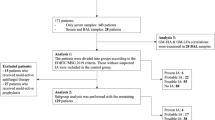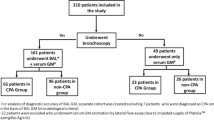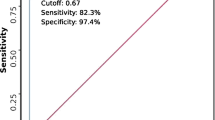Opinion statement
Invasive aspergillosis is the cause of severe morbidity and mortality in immunocompromised patients. Given the challenges of fungal cultures, non-culture surrogates are crucial to the timely diagnosis of invasive aspergillosis (IA) to initiate expedited treatment. The Platelia™ Aspergillus EIA (Bio-Rad, Hercules, California) is a double-sandwich ELISA that detects the galactomannan (GM) of the fungal cell wall and was cleared by the FDA for use in serum and bronchoalveolar fluid (BAL) in 2003 and 2011, respectively. The population in which GM has been studied the most and has shown the greatest accuracy is that of hematologic malignancy. The optimal optical density index (ODI) cutoff to define test positivity in the serum is still a matter of debate because this value influences test performance. Using a lower ODI threshold (≥0.5 vs. ≥1 vs. ≥1.5) optimizes sensitivity at the expense of specificity and vice versa using a higher ODI threshold. One must be alert to the potential for false-positive results, particularly if a ODI cutoff of 0.5 is used in the serum. False positives can occur due to medications, i.e., piperacillin/tazobactam, though there is increasing evidence that newer formulations are less cross-reactive with GM, and false-positive results occur in the presence of other molds that cross-react with GM. As the use of mold-active antifungal prophylaxis increases, one must be aware that GM may not perform as well due to lower pre-test probability of IA and lower test sensitivity. Emerging evidence indicates that use of GM in combination with other tests, e.g., Aspergillus PCR or lateral flow device (LFD), may enhance diagnostic accuracy beyond GM alone; however, further validation of these diagnostics in combination are required before routine implementation can be recommended. BAL GM performs better than serum as it is significantly more sensitive, though the optimal ODI cutoff is also debated (≥0.5 vs. ≥1).False-positive results can be due to use of medications, as with serum GM. False negatives can occur with the use of certain agents which decrease the viscosity of the BAL fluid, and use of such agents need to be considered by the clinician when evaluating a test result. Again, BAL GM, in conjunction with other tests, e.g., PCR and LFD, are promising, but further studies are needed. GM in other fluids, i.e., CSF, urine, and tissue, may be useful, but the studies are very limited. In summary, when employed in the right clinical context and interpreted appropriately, serum and BAL GM can facilitate the diagnosis and early treatment of IA. While there are significant limitations and the landscape is evolving, the test has an important role in clinical practice today.
Similar content being viewed by others
References and Recommended Reading
Papers of particular interest, published recently, have been highlighted as: •• Of major importance
http://www.bio-rad.com/webroot/web/pdf/inserts/CDG/en/62796_881045_EN.pdf. Accessed 15 June 2015.
De Pauw B, Walsh TJ, Donnelly JP, Stevens DA, Edwards JE, Calandra T, et al. Revised definitions of invasive fungal disease from the European Organization for Research and Treatment of Cancer/Invasive Fungal Infections Cooperative Group and the National Institute of Allergy and Infectious Diseases Mycoses Study Group (EORTC/MSG) Consensus Group. Clin Infect Dis. 2008;46(12):1813–21. doi:10.1086/588660.
http://www.fda.gov/downloads/Drugs/GuidanceComplianceRegulatoryInformation/Guidances/UCM420234.pdf. Accessed 15 June 2015.
Pfeiffer CD, Fine JP, Safdar N. Diagnosis of invasive aspergillosis using a galactomannan assay: a meta-analysis. Clin Infect Dis. 2006;42(10):1417–27. doi:10.1086/503427.
Leeflang MM, Debets-Ossenkopp YJ, Visser CE, Scholten RJ, Hooft L, Bijlmer HA, et al. Galactomannan detection for invasive aspergillosis in immunocompromized patients. Cochrane Database Syst Rev. 2008;4, CD007394. doi:10.1002/14651858.CD007394.
Fukuda T, Boeckh M, Carter RA, Sandmaier BM, Maris MB, Maloney DG, et al. Risks and outcomes of invasive fungal infections in recipients of allogeneic hematopoietic stem cell transplants after nonmyeloablative conditioning. Blood. 2003;102(3):827–33. doi:10.1182/blood-2003-02-0456.
Viscoli C, Machetti M, Cappellano P, Bucci B, Bruzzi P, Van Lint MT, et al. False-positive galactomannan platelia Aspergillus test results for patients receiving piperacillin-tazobactam. Clin Infect Dis. 2004;38(6):913–6. doi:10.1086/382224.
Mikulska M, Furfaro E, Del Bono V, Raiola AM, Ratto S, Bacigalupo A, et al. Piperacillin/tazobactam (Tazocin) seems to be no longer responsible for false-positive results of the galactomannan assay. J Antimicrob Chemother. 2012;67(7):1746–8. doi:10.1093/jac/dks111.
Vergidis P, Razonable RR, Wheat LJ, Estes L, Caliendo AM, Baden LR, et al. Reduction in false-positive Aspergillus serum galactomannan enzyme immunoassay results associated with use of piperacillin-tazobactam in the United States. J Clin Microbiol. 2014;52(6):2199–201. doi:10.1128/JCM.00285-14.
Surmont I, Stockman W. Gluconate-containing intravenous solutions: another cause of false-positive galactomannan assay reactivity. J Clin Microbiol. 2007;45(4):1373. doi:10.1128/JCM.02373-06.
Duarte RF, Sanchez-Ortega I, Cuesta I, Arnan M, Patino B, Fernandez de Sevilla A, et al. Serum galactomannan-based early detection of invasive aspergillosis in hematology patients receiving effective antimold prophylaxis. Clin Infect Dis. 2014;59(12):1696–702. doi:10.1093/cid/ciu673. This study shows lower incidence of IA in setting of prophylaxis and calls for new roll of GM surveillance.
Marr KA, Laverdiere M, Gugel A, Leisenring W. Antifungal therapy decreases sensitivity of the Aspergillus galactomannan enzyme immunoassay. Clin Infect Dis. 2005;40(12):1762–9. doi:10.1086/429921.
Arvanitis M, Ziakas PD, Zacharioudakis IM, Zervou FN, Caliendo AM, Mylonakis E. PCR in diagnosis of invasive aspergillosis: a meta-analysis of diagnostic performance. J Clin Microbiol. 2014;52(10):3731–42. doi:10.1128/JCM.01365-14.
Mengoli C, Cruciani M, Barnes RA, Loeffler J, Donnelly JP. Use of PCR for diagnosis of invasive aspergillosis: systematic review and meta-analysis. Lancet Infect Dis. 2009;9(2):89–96. doi:10.1016/S1473-3099(09)70019-2.
White PL, Bretagne S, Klingspor L, Melchers WJ, McCulloch E, Schulz B, et al. Aspergillus PCR: one step closer to standardization. J Clin Microbiol. 2010;48(4):1231–40. doi:10.1128/JCM.01767-09.
White PL, Mengoli C, Bretagne S, Cuenca-Estrella M, Finnstrom N, Klingspor L, et al. Evaluation of Aspergillus PCR protocols for testing serum specimens. J Clin Microbiol. 2011;49(11):3842–8. doi:10.1128/JCM.05316-11.
Aguado JM, Vazquez L, Fernandez-Ruiz M, Villaescusa T, Ruiz-Camps I, Barba P, et al. Serum galactomannan versus a combination of galactomannan and polymerase chain reaction-based Aspergillus DNA detection for early therapy of invasive aspergillosis in high-risk hematological patients: a randomized controlled trial. Clin Infect Dis. 2015;60(3):405–14. doi:10.1093/cid/ciu833. This study demonstrated utility of PCR plus GM for early IA diagnosis.
http://www.olmdiagnostics.com/published-data/2/aspergillosis. Accessed 15 June 2015.
Thornton CR. Development of an immunochromatographic lateral-flow device for rapid serodiagnosis of invasive aspergillosis. Clin Vaccine Immunol CVI. 2008;15(7):1095–105. doi:10.1128/CVI.00068-08.
White PL, Parr C, Thornton C, Barnes RA. Evaluation of real-time PCR, galactomannan enzyme-linked immunosorbent assay (ELISA), and a novel lateral-flow device for diagnosis of invasive aspergillosis. J Clin Microbiol. 2013;51(5):1510–6. doi:10.1128/JCM.03189-12.
Lamoth F, Cruciani M, Mengoli C, Castagnola E, Lortholary O, Richardson M, et al. beta-Glucan antigenemia assay for the diagnosis of invasive fungal infections in patients with hematological malignancies: a systematic review and meta-analysis of cohort studies from the Third European Conference on Infections in Leukemia (ECIL-3). Clin Infect Dis. 2012;54(5):633–43. doi:10.1093/cid/cir897.
Kanamori H, Kanemitsu K, Miyasaka T, Ameku K, Endo S, Aoyagi T, et al. Measurement of (1–3)-beta-D-glucan derived from different gauze types. Tohoku J Exp Med. 2009;217(2):117–21.
Kimura Y, Nakao A, Tamura H, Tanaka S, Takagi H. Clinical and experimental studies of the limulus test after digestive surgery. Surg Today. 1995;25(9):790–4.
Marty FM, Lowry CM, Lempitski SJ, Kubiak DW, Finkelman MA, Baden LR. Reactivity of (13)-beta-d-glucan assay with commonly used intravenous antimicrobials. Antimicrob Agents Chemother. 2006;50(10):3450–3. doi:10.1128/AAC.00658-06.
Hanson KE, Pfeiffer CD, Lease ED, Balch AH, Zaas AK, Perfect JR, et al. beta-D-glucan surveillance with preemptive anidulafungin for invasive candidiasis in intensive care unit patients: a randomized pilot study. PLoS One. 2012;7(8):e42282. doi:10.1371/journal.pone.0042282.
Mohr JF, Sims C, Paetznick V, Rodriguez J, Finkelman MA, Rex JH, et al. Prospective survey of (13)-beta-D-glucan and its relationship to invasive candidiasis in the surgical intensive care unit setting. J Clin Microbiol. 2011;49(1):58–61. doi:10.1128/JCM.01240-10.
Mennink-Kersten MA, Warris A, Verweij PE. 1,3-beta-D-glucan in patients receiving intravenous amoxicillin-clavulanic acid. N Engl J Med. 2006;354(26):2834–5. doi:10.1056/NEJMc053340.
Mennink-Kersten MA, Ruegebrink D, Verweij PE. Pseudomonas aeruginosa as a cause of 1,3-beta-D-glucan assay reactivity. Clin Infect Dis. 2008;46(12):1930–1. doi:10.1086/588563.
Pickering JW, Sant HW, Bowles CA, Roberts WL, Woods GL. Evaluation of a (1- > 3)-beta-D-glucan assay for diagnosis of invasive fungal infections. J Clin Microbiol. 2005;43(12):5957–62. doi:10.1128/JCM.43.12.5957-5962.2005.
Hadrich I, Makni F, Cheikhrouhou F, Neji S, Amouri I, Sellami H, et al. Clinical utility and prognostic value of galactomannan in neutropenic patients with invasive aspergillosis. Pathol Biol. 2012;60(6):357–61. doi:10.1016/j.patbio.2011.10.011.
Fisher CE, Stevens AM, Leisenring W, Pergam SA, Boeckh M, Hohl TM. The serum galactomannan index predicts mortality in hematopoietic stem cell transplant recipients with invasive aspergillosis. Clin Infect Dis. 2013;57(7):1001–4. doi:10.1093/cid/cit393.
Chai LY, Kullberg BJ, Johnson EM, Teerenstra S, Khin LW, Vonk AG, et al. Early serum galactomannan trend as a predictor of outcome of invasive aspergillosis. J Clin Microbiol. 2012;50(7):2330–6. doi:10.1128/JCM.06513-11.
Marr KA, Schlamm HT, Herbrecht R, Rottinghaus ST, Bow EJ, Cornely OA, et al. Combination antifungal therapy for invasive aspergillosis: a randomized trial. Ann Intern Med. 2015;162(2):81–9. doi:10.7326/M13-2508.
Chai LY, Kullberg BJ, Earnest A, Johnson EM, Teerenstra S, Vonk AG, et al. Voriconazole or amphotericin B as primary therapy yields distinct early serum galactomannan trends related to outcomes in invasive aspergillosis. PLoS One. 2014;9(2), e90176. doi:10.1371/journal.pone.0090176.
http://www.accessdata.fda.gov/cdrh_docs/pdf9/K093678.pdf. Accessed 15 June 2015.
Prattes J, Koidl C, Eigl S, Krause R, Hoenigl M. Bronchoalveolar lavage fluid sample pretreatment with Sputasol((R)) significantly reduces galactomannan levels. J Infect. 2015;70(5):541–3. doi:10.1016/j.jinf.2014.11.005.
Guo YL, Chen YQ, Wang K, Qin SM, Wu C, Kong JL. Accuracy of BAL galactomannan in diagnosing invasive aspergillosis: a bivariate metaanalysis and systematic review. Chest. 2010;138(4):817–24. doi:10.1378/chest.10-0488.
Zou M, Tang L, Zhao S, Zhao Z, Chen L, Chen P, et al. Systematic review and meta-analysis of detecting galactomannan in bronchoalveolar lavage fluid for diagnosing invasive aspergillosis. PLoS One. 2012;7(8), e43347. doi:10.1371/journal.pone.0043347.
D’Haese J, Theunissen K, Vermeulen E, Schoemans H, De Vlieger G, Lammertijn L, et al. Detection of galactomannan in bronchoalveolar lavage fluid samples of patients at risk for invasive pulmonary aspergillosis: analytical and clinical validity. J Clin Microbiol. 2012;50(4):1258–63. doi:10.1128/JCM.06423-11.
Avni T, Levy I, Sprecher H, Yahav D, Leibovici L, Paul M. Diagnostic accuracy of PCR alone compared to galactomannan in bronchoalveolar lavage fluid for diagnosis of invasive pulmonary aspergillosis: a systematic review. J Clin Microbiol. 2012;50(11):3652–8. doi:10.1128/JCM.00942-12.
Sun W, Wang K, Gao W, Su X, Qian Q, Lu X, et al. Evaluation of PCR on bronchoalveolar lavage fluid for diagnosis of invasive aspergillosis: a bivariate metaanalysis and systematic review. PLoS One. 2011;6(12), e28467. doi:10.1371/journal.pone.0028467.
Heng SC, Chen SC, Morrissey CO, Thursky K, Manser RL, De Silva HD, et al. Clinical utility of Aspergillus galactomannan and PCR in bronchoalveolar lavage fluid for the diagnosis of invasive pulmonary aspergillosis in patients with haematological malignancies. Diagn Microbiol Infect Dis. 2014;79(3):322–7. doi:10.1016/j.diagmicrobio.2014.03.020.
Hoenigl M, Koidl C, Duettmann W, Seeber K, Wagner J, Buzina W, et al. Bronchoalveolar lavage lateral-flow device test for invasive pulmonary aspergillosis diagnosis in haematological malignancy and solid organ transplant patients. J Infect. 2012;65(6):588–91. doi:10.1016/j.jinf.2012.10.003.
Willinger B, Lackner M, Lass-Florl C, Prattes J, Posch V, Selitsch B, et al. Bronchoalveolar lavage lateral-flow device test for invasive pulmonary aspergillosis in solid organ transplant patients: a semiprospective multicenter study. Transplantation. 2014;98(8):898–902. doi:10.1097/TP.0000000000000153.
Miceli MH, Goggins MI, Chander P, Sekaran AK, Kizy AE, Samuel L, et al. Performance of lateral flow device and galactomannan for the detection of Aspergillus species in bronchoalveolar fluid of patients at risk for invasive pulmonary aspergillosis. Mycoses. 2015;58(6):368–74. doi:10.1111/myc.12327.
Eigl S, Prattes J, Lackner M, Willinger B, Spiess B, Reinwald M, et al. Multicenter evaluation of a lateral-flow device test for diagnosing invasive pulmonary aspergillosis in ICU patients. Crit Care. 2015;19:178. doi:10.1186/s13054-015-0905-x.
Hoenigl M, Prattes J, Spiess B, Wagner J, Prueller F, Raggam RB, et al. Performance of galactomannan, beta-d-glucan, Aspergillus lateral-flow device, conventional culture, and PCR tests with bronchoalveolar lavage fluid for diagnosis of invasive pulmonary aspergillosis. J Clin Microbiol. 2014;52(6):2039–45. doi:10.1128/JCM.00467-14. This study demonstrated utility of rapid, point-of-care test for BAL testing of Aspergillus LFD.
Maertens J, Verhaegen J, Demuynck H, Brock P, Verhoef G, Vandenberghe P, et al. Autopsy-controlled prospective evaluation of serial screening for circulating galactomannan by a sandwich enzyme-linked immunosorbent assay for hematological patients at risk for invasive Aspergillosis. J Clin Microbiol. 1999;37(10):3223–8.
Coates M, Wilson J. Central nervous system aspergillus infection complicating renal transplantation. Australas Radiol. 2001;45(3):338–42.
Viscoli C, Machetti M, Gazzola P, De Maria A, Paola D, Van Lint MT, et al. Aspergillus galactomannan antigen in the cerebrospinal fluid of bone marrow transplant recipients with probable cerebral aspergillosis. J Clin Microbiol. 2002;40(4):1496–9.
Reinwald M, Buchheidt D, Hummel M, Duerken M, Bertz H, Schwerdtfeger R, et al. Diagnostic performance of an Aspergillus-specific nested PCR assay in cerebrospinal fluid samples of immunocompromised patients for detection of central nervous system aspergillosis. PLoS One. 2013;8(2), e56706. doi:10.1371/journal.pone.0056706.
Suwantarat N, Lee R, Carroll KC, Zhang SX. Questionable utility of galactomannan testing for diagnosis of Exserohilum rostratum infection. J Clin Microbiol. 2014;52(7):2742–3. doi:10.1128/JCM.01148-14.
Lockhart SR, Pham CD, Gade L, Iqbal N, Scheel CM, Cleveland AA, et al. Preliminary laboratory report of fungal infections associated with contaminated methylprednisolone injections. J Clin Microbiol. 2013;51(8):2654–61. doi:10.1128/JCM.01000-13.
Klont RR, Mennink-Kersten MA, Verweij PE. Utility of Aspergillus antigen detection in specimens other than serum specimens. Clin Infect Dis. 2004;39(10):1467–74. doi:10.1086/425317.
Haynes KA, Latge JP, Rogers TR. Detection of Aspergillus antigens associated with invasive infection. J Clin Microbiol. 1990;28(9):2040–4.
Duettmann W, Koidl C, Troppan K, Seeber K, Buzina W, Wolfler A, et al. Serum and urine galactomannan testing for screening in patients with hematological malignancies. Med Mycol. 2014;52(6):647–52. doi:10.1093/mmy/myu019.
Dufresne SF, Datta K, Li X, Dadachova E, Staab JF, Patterson TF, et al. Detection of urinary excreted fungal galactomannan-like antigens for diagnosis of invasive aspergillosis. PLoS One. 2012;7(8), e42736. doi:10.1371/journal.pone.0042736.
Acknowledgments
The authors would like to thank Graeme Forrest, MBBS, for his thoughtful review of the manuscript.
Compliance with Ethics Guidelines
Conflict of Interest
Corinne Klein declares that she has no conflict of interest. Christopher Pfeiffer declares that he has no conflict of interest.
Human and Animal Rights and Informed Consent
This article does not contain any studies with human or animal subjects performed by the author.
Author information
Authors and Affiliations
Corresponding author
Additional information
This article is part of the Topical Collection on Fungal Infections
Rights and permissions
About this article
Cite this article
Klein, C.N., Pfeiffer, C.D. Diagnosis of Invasive Aspergillosis: Use of the Galactomannan Assay. Curr Treat Options Infect Dis 7, 163–175 (2015). https://doi.org/10.1007/s40506-015-0055-3
Published:
Issue Date:
DOI: https://doi.org/10.1007/s40506-015-0055-3
Keywords
- Diagnosis
- Culture
- Blood culture, invasive aspergillosis
- Aspergillus, galactomannan
- Beta-d-glucan
- PCR
- Aspergillus lateral flow device
- Bronchoalveolar lavage
- Serum
- FDA
- Platelia
- Treatment
- Prognosis
- Invasive fungal disease
- Piperacillin/tazobactam
- False positive
- Antifungal therapy
- Performance
- Accuracy
- Diagnostic odds ratio
- Meta-analysis
- Systematic review
- Optical density index
- Plasma-Lyte
- Voriconazole
- Posaconazole
- Epidemiology




